You also want an ePaper? Increase the reach of your titles
YUMPU automatically turns print PDFs into web optimized ePapers that Google loves.
<strong>The</strong> <strong>Blair</strong> <strong>VIP</strong> <strong>Toilet</strong><br />
Manual for the upgradeable B<strong>VIP</strong> model<br />
with spiral superstructure and tubular vent pipe<br />
Peter Morgan<br />
Aquamor, Harare<br />
January 2011
Introduction<br />
In 2010 the Government of Zimbabwe relaxed its technical policy guideline<br />
for family toilets (the spiral brick <strong>Blair</strong> <strong>VIP</strong>) to include an additional design<br />
called an Upgradeable B<strong>VIP</strong> (uB<strong>VIP</strong>). In this version the basic requirement<br />
is for a brick lined pit and a covering concrete slab, which allows the owner<br />
to upgrade in a sequence of steps to attain the final brick built <strong>Blair</strong> <strong>VIP</strong>.<br />
<strong>The</strong> starting point is a brick lined pit of suitable capacity capped by a slab<br />
which has both squat and vent holes. <strong>The</strong> government specifies that the<br />
range of vent pipe options should include those made from bricks as well as<br />
tubes (eg PVC or asbestos etc). It is a requirement that the minimum life of<br />
the pit be at least 10 years. However recent developments in manufacture<br />
have significantly reduced the cost of PVC pipes. It already well<br />
established that tubular vents are more efficient than brick pipes, and<br />
therefore there is a place for them in modern B<strong>VIP</strong> technology. <strong>The</strong>re are<br />
certain other advantages in using tubular pipes. <strong>The</strong> configuration of the<br />
concrete slab can be modified to reduce the number of bricks used and also<br />
the ease of construction. A manual has already been written on the uB<strong>VIP</strong><br />
designed for use with a brick (or tubular) pipe. This manual describes the<br />
construction of a B<strong>VIP</strong> designed specifically for the tubular 110mm pipe.<br />
In modern Zimbabwe an era of constraint dictates that cement should be<br />
used sparingly so that the investment made is good value for money and<br />
time. Consequently a smaller, lighter and more economical 1.2m diameter<br />
concrete slab has been designed. This uses 12 litres of Portland cement and<br />
60 litres of clean river sand (5:1) and 3mm or barbed wire for reinforcing.<br />
<strong>The</strong> method of construction of the brick lined pit has also been streamlined.<br />
<strong>The</strong> depth is shallower than older pits (2m rather than 3m), but it is also<br />
wider (1.4m rather than 1.1m). In order for the wider pit lining to connect<br />
to the small diameter slab, a method known as corbelling is used – where<br />
the upper courses of brickwork are stepped in to the required diameter that<br />
will support the slab (1.2m). This revised method of pit lining is easier to<br />
construct since the builder can stand on the base of the pit throughout the<br />
construction. Also a well tested method of using a much weaker cement<br />
mortar has been introduced for bonding the pit brickwork. This consists of<br />
20 parts pit sand and 1 part Portland cement. This well researched revision<br />
of the construction method means that a single 50kg bag of Portland<br />
cement is sufficient to line a pit and caste a suitable concrete slab.<br />
2
Start simple and upgrade - an explanation<br />
It is possible to construct the well known standardised brick built <strong>Blair</strong><br />
Ventilated Improved Pit (B<strong>VIP</strong>) toilet in a single building operation.<br />
Hundreds of thousands of these units have been built throughout<br />
Zimbabwe, and most have been built with the generous support of donor<br />
organisations. <strong>The</strong> “<strong>Blair</strong>” is popular because it doubles as a wash room<br />
and the square spiral structure without a door has become the most popular.<br />
<strong>The</strong> B<strong>VIP</strong> is a pit toilet and eventually the pit fills up. <strong>The</strong> filling time<br />
varies between 10 and 20 years depending on pit capacity, the number of<br />
users and the amount of garbage which is thrown down the pit. However<br />
eventually the pit fills up and another toilet is required by the family. A<br />
standardised brick built B<strong>VIP</strong> requires several bags of cement and a trained<br />
builder to construct and this cost is beyond the means of most rural<br />
Zimbabweans. A new concept therefore had to be found which was far<br />
more affordable and adaptable and could provided a valuable starting point<br />
from which rural families could build a variety of toilets including the<br />
standardised brick B<strong>VIP</strong>. <strong>The</strong> starting point technology and the process<br />
whereby it can be upgraded is called the Upgradeable B<strong>VIP</strong> (uB<strong>VIP</strong>).<br />
This basic unit consists of a brick lined pit and a concrete cover slab. This is the<br />
technical starting point from which a considerable range of pit toilets can be built,<br />
including the brick B<strong>VIP</strong>. A single 50kg bag of Portland cement together with<br />
about 500 bricks, river and pit sand and some reinforcing wire is sufficient to line<br />
and cover a brick lined pit which should provide at least a ten year life. <strong>The</strong><br />
superstructure which is built on top and around the slab normally remains the<br />
responsibility of the owner. <strong>The</strong> structure built by the family above the slab<br />
provides just privacy at first. In the absence of a vent pipe, smells and flies can be<br />
reduced by the regular addition of wood ash and regular washing down of the slab.<br />
A loose fitting wooden or metal cover placed over the squat hole also helps. Also<br />
simple fly traps used in conjunction with the cover plate can reduce fly emission<br />
into the environment.<br />
<strong>The</strong> basic aim of this new approach is to provide, at relatively low cost, a<br />
system which can considerably reduce the extent of open defecation (in the<br />
absence of any toilet), and has the potential to be upgraded into the familiar<br />
B<strong>VIP</strong> over time. “Farm brick” are common in most parts of Zimbabwe and<br />
are produced locally and at low cost. Where bricks are not easily available<br />
alternative approaches must be found.<br />
3
How the <strong>Blair</strong> <strong>VIP</strong> works<br />
<strong>The</strong> <strong>Blair</strong> <strong>VIP</strong> is a ventilated pit toilet. <strong>The</strong> toilet slab is made with two<br />
openings, one for the squat hole and one for the ventilation pipe which is<br />
fitted with a corrosion resistant fly screen. <strong>The</strong> vent pipe sucks out air from<br />
the pit and fresh air is drawn down through the squat hole. <strong>The</strong> toilet itself<br />
should therefore remain fairly free of odours if the toilet floor is kept clean<br />
and washed down.<br />
Flies approaching the toilet are attracted to odours coming from the pipe,<br />
but cannot pass the fly screen to enter the pit. Any flies escaping from the<br />
toilet are attracted to light coming down the pipe. But these will be trapped<br />
in the pipe. All <strong>Blair</strong> <strong>VIP</strong>s are fitted with a roof and a semi dark inside.<br />
How it works<br />
4
Materials required<br />
<strong>The</strong> Upgradeable B<strong>VIP</strong> is constructed in two stages. <strong>The</strong> first stage is<br />
the pit lining and the construction and fitting of the concrete slab.<br />
<strong>The</strong> second stage is the construction of the superstructure.<br />
Stage 1. <strong>The</strong> pit lining and concrete slab stage<br />
Portland cement (PC15) – 1 X 50kg bag<br />
River sand – 60 litres (for slab)<br />
Pit sand – about ½ cu.m. (for making cement mortar for bricks)<br />
Reinforcing wire – 12m of 3mm or barbed wire (for slab)<br />
Bricks (fired). 450 (standard size is 225mmX 112mmX75mm)<br />
Stage 2. <strong>The</strong> superstructure<br />
<strong>The</strong> materials for the superstructure vary considerably depending on<br />
the type of structure built.<br />
1. Simple grass and pole structure (spiral).<br />
<strong>The</strong> minimum will be about 10 treated gum poles and grass and wire<br />
and binding string. Poles, plastic sheeting and grass for simple roof.<br />
2. Brick structure (new spiral configuration)<br />
Bricks for foundations (50+) and superstructure (450) = 500<br />
Portland cement. 20 litres (0.5 bag) if cement is used for wall<br />
bonding. Or if internal plaster 1 x 50kg bag.<br />
Traditional mortar: 1 part ant hill soil and 2 parts sandy soil.<br />
River Sand. 50 litres for slab extension and toilet floor<br />
Pit Sand. For brick foundation, wall bonding and plastering (500li)<br />
Roof . Wooden frame: (1x2m x76mm x 50mm + 1x 2m x38mm x<br />
38mm + 5x 0.95m 38mmx 38mm. Corrugated tin sheet 3 X 1.5m.<br />
Vent 1 X 2.5m X 110mm PVC fitted with aluminium flyscreen<br />
Measuring the cement<br />
<strong>The</strong> 12 litres of cement required for making the concrete slab is one level 10litre<br />
bucket full. Each bucket is filled with material which is tapped down and leveled<br />
off. <strong>The</strong> 20:1 cement mortar used for bonding brickwork is best measured using a 5<br />
litre container. 5 litres of cement is mixed with 100 litres of pit sand to make the<br />
mortar. Two full wheel barrows contains about 100 litres of sand.<br />
5
SITING THE uB<strong>VIP</strong><br />
<strong>The</strong> site should be chosen by the family with assistance from the<br />
Environmental Health Technician and should be at least 30<br />
metres from a well. <strong>The</strong> toilet site should be:<br />
*Down hill from a well or borehole – to reduce possible<br />
underground contamination of the water supply.<br />
*Where the soil is firm – to avoid possible latrine collapse<br />
*On slightly raised ground – so that rainwater can drain<br />
away from the site of the toilet<br />
*Near the house – for the convenience of the householders<br />
*Away from trees – so that air can flow easily over the<br />
pipe<br />
*<strong>The</strong> orientation of the structure - to provide the best<br />
privacy for the users<br />
Stages of construction<br />
<strong>The</strong> stages of construction are as follows:<br />
1. Dig the pit.<br />
2. Make the concrete slab<br />
3. Line the pit with bricks and fit the cured slab<br />
4. Build the superstructure<br />
Stage 1. Dig the pit<br />
Dig a round pit 2m deep and 1.7m in diameter. Dig the<br />
pit with straight sides and a flat bottom.<br />
6
Stage 2. <strong>The</strong> concrete slab<br />
<strong>The</strong> concrete slab for the uB<strong>VIP</strong> is 1.2m in diameter and made with a mix of<br />
12litres of Portland cement and 60 litres of clean river sand (1:5 mix). <strong>The</strong><br />
hole for the vent is 110mm in diameter and the squat hole measures 300mm X<br />
150mm. <strong>The</strong> vent hole is designed for a 110mm PVC pipe which is placed<br />
inside the structure. <strong>The</strong> 110mm hole is placed 110 – 112mm from the edge of<br />
the slab and the vent and squat holes are about 200mm apart. <strong>The</strong><br />
arrangement of the holes are shown in the photo. <strong>The</strong> vent hole is made by<br />
using a short length (75mm) of PVC pipe as mould. <strong>The</strong> squat hole in this case<br />
is made using a specially designed steel mould. 12m of steel wire or barbed<br />
wire is required for reinforcing per (4 X1.1m + 5 X 1m + 4 X 0.6m).<strong>The</strong> slab is<br />
cast over plastic sheet or on levelled ground covered with sand which is wetted<br />
down. One level 10 litre plastic bucket contains 12 litres of material. One level<br />
10 litre bucket of cement and 5 level buckets of river sand are used.<br />
Details of concrete slab for uB<strong>VIP</strong> with tubular pipe<br />
7
Making the concrete slab<br />
A mix of 12litres of cement (one level 10litre plastic bucket) and 60 litres<br />
of clean river sand (five level 10 litre plastic buckets) is thoroughly mixed<br />
and water added to make a slurry-like concrete. This is added into the<br />
shuttering around the vent and squat hole moulds which are held in position<br />
whilst the concrete is added. Half the concrete mix is added first and<br />
levelled off. <strong>The</strong>n the lengths of 3mm reinforcing wire or barbed wire are<br />
added as shown. <strong>The</strong> wires are added in a grid formation about 15cm apart.<br />
About 12m of wire is required and cut up. <strong>The</strong> remainder of the concrete<br />
mix is added and smoothed down. After about 2 hours the squat hole and<br />
vent hole moulds are removed. <strong>The</strong> outer shuttering is also removed. <strong>The</strong><br />
slab is covered with plastic sheet and left overnight to harden. <strong>The</strong><br />
following morning it is carefully watered and covered again. To gain the<br />
proper strength before moving the slab should be kept wet and covered for<br />
at least 7 days. It can then be lifted carefully and place on the upper course<br />
of pit lining brickwork in a bed of weak cement mortar. It must be level.<br />
Half the concrete mix is added first. <strong>The</strong>n the wire reinforcing is added.<br />
<strong>The</strong> 3 – 4mm wire reinforcing is cut and laid in a grid formation 15cm apart.<br />
Once the wires have been laid, with an extra piece between vent hole and slab<br />
rim, the remainder of the concrete is added and smoothed down flat.<br />
8
Stage 3.<br />
Line the pit with bricks using the corbelling technique<br />
Whilst the slab is curing the pit can be dug and lined with bricks. A<br />
technique known as corbelling is used where the upper courses of<br />
brickwork are stepped in, so the diameter of the pit is reduced nearer the<br />
top of the pit. This allows a large diameter pit to be used together with a<br />
smaller and economic concrete slab which caps the pit. This technique<br />
allows for a large diameter pit to be built which is shallower (total depth<br />
2m with 0.2m above ground level) and this easier to build.<br />
<strong>The</strong> pit has ben dug 2m deep and 1.7m wide. Line the pit from the bottom<br />
with strong fired bricks. Using a cement mortar mix of 20 parts of pit sand<br />
and 1 part Portland cement (5 litres cement in 100 litres pit sand). <strong>The</strong><br />
inside diameter of the first 1metre of brickwork must be 1.4m (about 19<br />
bricks per course). Retain this internal diameter (1.4m) diameter for 1.4m<br />
above the pit bottom and then start to step in the brickwork Each additional<br />
course above 1.4m should be stepped in by about 20mm above the lower<br />
course. <strong>The</strong> brickwork should continue above ground level by about 20cm<br />
so the full pit depth is about 2.2m. This will take about 24 courses of bricks<br />
depending on brick size. <strong>The</strong> uppermost course of bricks uses about 15<br />
bricks. <strong>The</strong> total number of bricks (standard size – 220mm x 110mm X<br />
75mm) is about 500. <strong>The</strong> amount of cement in a single 50kg bag should be<br />
enough to make the slab, line the pit and leave some spare to make either<br />
the foundations of the spiral brick toilet or the extended floor in front of the<br />
slab for a doored toilet.<br />
<strong>The</strong> pit is dug 1.7m wide and 2m deep. Walls are straight and bottom flat<br />
9
Ensure the walls are vertical and the pit base flat. <strong>The</strong> mortar mix is made<br />
with 5li of Portland cement and 100li of pit sand (20:1). It works!<br />
Lay the bricks against the edge of the pit wall. <strong>The</strong> mortar is quite thin but<br />
sufficient to bond the bricks together. <strong>The</strong> internal diameter is 1.4m. Continue<br />
with this diameter for 1.4m<br />
A simple ladder can be made to enter and leave the pit. After 1.4m each brick<br />
course is stepped in (corbelled) by about 20mm per course. This corbelling<br />
continues till the brickwork is about 2 courses above ground level.<br />
10
<strong>The</strong> brickwork is stepped in at each course. <strong>The</strong> brickwork should rise about<br />
2 courses above ground level with a final external diameter of just over 1.2m<br />
<strong>The</strong> annular space between pit wall and brickwork is filled in and rammed<br />
hard.<br />
<strong>The</strong> 1.2m diameter slab is carefully raised and washed and then rolled on to<br />
site. A bed of weak (20:1) cement mortar is laid on the brickwork, so that the<br />
slab can be bedded in it.<br />
11
<strong>The</strong> slab is lowered down on to the brick work in the correct orientation that<br />
will suit the structure. <strong>The</strong> slab is made flat by adding small stones under the<br />
slab where it is low and filling with cement mortar.<br />
<strong>The</strong> orientation of the slab<br />
<strong>The</strong> orientation of the slab depends on the type of structure to be built. In<br />
this case a round spiral brick structure will be built. In a more recent<br />
development the orientation of the slab has been changed so the squat hole<br />
faces the entrance. This configuration makes the spiral wall easier to<br />
construct and also uses fewer bricks. Special wooden templates can be used<br />
to make the construction easier and faster.<br />
In this new and economic configuration the squat hole faces the entrance. <strong>The</strong><br />
bricks are built around the rim of the slab and continue around the rim of the<br />
concrete extension to the slab. This configuration combined with the use of<br />
wooden templates makes the spiral structure easier to build.<br />
12
uB<strong>VIP</strong> Superstructures<br />
<strong>The</strong> concept behind the uB<strong>VIP</strong> is that once the first stage is complete (the<br />
construction of a lined pit and cover slab), the further construction of the<br />
superstructure is primarily for privacy and this stage is in the hands of the<br />
owner/user. <strong>The</strong> slab used in the first stage is very versatile and can be used<br />
to make a range of simple toilets with the superstructures made of poles,<br />
grass or reeds. However at not much greater expense a more durable brick<br />
structure can be built on the same slab. This section describes one example<br />
of a grass structure which can be built with locally available materials.<br />
Simpler structures first<br />
Once the pit has been lined with bricks and capped by a durable concrete<br />
slab, the construction of the superstructure can begin. <strong>The</strong> family must<br />
decide what it can afford. At first this may be a simple grass and pole<br />
structure built for privacy only and not fitted with a roof or vent pipe. <strong>The</strong><br />
preference is for a brick built superstructure which has no moving parts,<br />
like doors. Doors can be left open, and this will reduce fly control if the<br />
unit is upgraded to a B<strong>VIP</strong>. However in the first instance, the superstructure<br />
should be designed to provide privacy. In this way, the unit provides a start<br />
off structure, which can help to reduce open defecation at low cost. Over<br />
time the same substructure and slab can be upgraded in a series of steps to<br />
become the standard brick built <strong>Blair</strong> <strong>VIP</strong>, which doubles as a washroom.<br />
Wood ash can be added to the pit to reduce odour and flies if no roof and<br />
pipe are fitted. Also a tin or wooden sheet fitted over the squat hole can<br />
reduce fly nuisance and flies can also be trapped in a fly trap (see later).<br />
Pole and grass structures<br />
In the first instance the most easily built structures designed for privacy<br />
may be made with poles and grass. <strong>The</strong>se are temporary structures but will<br />
provide suitable privacy for a period of time. Such structures can be built<br />
with doors or in a spiral (door-less) form without doors. Gum poles may be<br />
the best poles to choose, but they are vulnerable to termite attack. <strong>The</strong> best<br />
gum poles will be pressure treated, but these will normally only be<br />
available in the city centres. Treatment of the poles can be undertaken by<br />
13
painting the poles, or the lower parts of the poles with old car engine oil,<br />
carbolineum or creosote or a combination of these. However, even these<br />
materials may not be available in the rural areas. Poles made of hardwood<br />
can be used if available. However depletion of natural woodlands is also<br />
not advisable. <strong>The</strong> burning of bricks also uses wood fuel, and these pose<br />
problems in terms of the negative effects of toilet building on the<br />
environment. A compromise can be sought by growing trees nearby the<br />
toilets. <strong>The</strong> growth of such trees, such as gum, can be enhanced by the<br />
application of diluted urine and also once the roots have penetrated more<br />
deeply can absorb nutrients provided by the composting excreta held in the<br />
pit. <strong>The</strong>se aspects will be described later in further literature prepared for<br />
this development.<br />
Construction of spiral pole and grass structure<br />
<strong>The</strong> simplest structure is made of poles and grass in a spiral shape. It is<br />
designed to provide privacy only and is not fitted, at first, with a roof or<br />
vent pipe. First the concrete floor is extended in front of the slab within a<br />
mould of bricks. Cement left over from the construction of the slab and<br />
lining of the pit should be enough to make this extension. <strong>The</strong> hole for the<br />
vent pipe is plugged with cement.<br />
Poles are placed around the slab in a spiral shape. Cement left over from the<br />
pit lining is used to make a cement floor in front of the slab. This cement can<br />
be extended into the entrance of the toilet. Note in this photo the slab-squatvent<br />
hole configuration is intended for a future brick or tubular pipe.<br />
14
Finishing off the floor and entrance<br />
In simple “start off” grass and pole structures, the aim is to provide<br />
privacy only. At first there will be no vent pipe added and the vent pipe<br />
hole is either filled with a weak concrete mix or a round disc of concrete is<br />
made up and fitted over the hole.<br />
Extension of the concrete floor made at the entrance. <strong>The</strong> vent hole can be<br />
plugged or capped with a concrete plug.<br />
<strong>The</strong> grass spiral superstructure<br />
<strong>The</strong> grass work is finished and neatened up.<br />
Pole and grass structures are only temporary and will eventually be<br />
eaten by termites. Old engine oil or carbolinium or a mix of both can<br />
be used to lengthen the life of pole and grass structures. Such<br />
structures can be built very neatly and work well, but eventually they<br />
should be replaced with brick superstructures. Flies and odours can<br />
be partly controlled by the liberal addition of wood ash to the pit and<br />
also by placing a loose tin cover over the squat hole. This cover can<br />
be moved by foot. Fly traps can also reduce the number of flies<br />
entering the environment in unventilated pit toilets.<br />
15
<strong>The</strong> concrete floor is extended in front of the slab and also within the spiral<br />
entrance. <strong>The</strong> vent hole has been temporarily plugged.<br />
Fly and odour control in unventilated pit toilets<br />
Simple pit toilets, built without vent pipes will smell and breed flies.<br />
But at first they will reduce open defecation in the environment.<br />
Smells can be reduced by washing down the slab regularly and<br />
adding wood ash down the pit. A cover plate can also be placed over<br />
the squat hole, when the toilet is not in use. <strong>The</strong> plate can be moved<br />
by foot. Fly breeding can become considerable and thousands of flies<br />
may be released in a few days. This is because they are attracted to<br />
the odour coming out of the squat hole. <strong>The</strong>y lay their eggs in<br />
thousands, which become larvae, the pupae then emerge as flies.<br />
Flies can be trapped by the use of a simple fly trap used in<br />
combination with the squat-hole cover plate. This is because flies are<br />
attracted to light when they emerge from a pit. <strong>The</strong>y will fly towards<br />
the strongest light source. <strong>The</strong> trap can be placed over the future vent<br />
pipe hole if it is opened up after being closed. <strong>The</strong> trap will only<br />
work, however, if the squat hole is covered with the cover plate. If<br />
the cover plate is not fitted over the squat hole, flies will emerge in<br />
their thousands from the squat hole. Adding a roof and making the<br />
interior darker will also help to reduce flies a little. <strong>The</strong> use of a roof,<br />
a cover plate and adding ash can help a lot. Washing the slab down<br />
regularly with water also helps as the smell of urine absorbed by the<br />
concrete also attracts flies.<br />
16
A fly trap<br />
<strong>The</strong> screened vent pipe of the B<strong>VIP</strong> is a fly trap as well as a ventilator.<br />
How its works has been described earlier. However at first the vent may not<br />
be available due its cost (the cost of tubular vents is going down rather than<br />
up). Many types of fly trap can be made. Those made of glass last longer<br />
than those made of plastic. <strong>The</strong> photos below show a fly trap in use in an<br />
unventilated pit toilet which has been built with a vent pipe hole, and where<br />
later a vent pipe be fitted.<br />
<strong>The</strong> parts of a glass fly trap made from the upper half of a glass bottle which<br />
has been cut in half using a method described on the next page. A glass jam<br />
jar is placed over the neck of the bottle to tap the flies<br />
A fly trap fitted over the vent pipe hole can only work if the squat hole is<br />
covered with a plate. In this case the plate is made of wood. Flat metal plates<br />
are better. <strong>The</strong>y stop light entering the pit through the squat hole, and thus<br />
emerging flies fly towards the light coming through the trap. <strong>The</strong> trap is<br />
emptied of dead flies from time to time. On the right a photo of flies<br />
accumulating in the trap.<br />
17
Making a flytrap from glass bottle<br />
This requires a little experimentation and great care. A glass bottle with long neck is<br />
taken and thick string is soaked in petrol and tied around the bottle about 10cm below<br />
the neck. Light the string so it burns all round then plunge the bottle in water. <strong>The</strong><br />
bottle should crack at the string point. Take care, wear goggles and gloves.<br />
Light the string and plunge into water<br />
Use the top of the bottle<br />
Encase the bottle top on concrete and allow to cure<br />
Mount the mounted bottle top over the vent hole and cover with a jam jar<br />
18
Upgrading the simple superstructure<br />
<strong>The</strong> simple grass spiral superstructure can be upgraded in several<br />
ways. A grass roof supported by poles with plastic sheet placed<br />
between the poles and the grass protects the users from rain and also<br />
shades the interior of the toilet. This helps to reduce fly ingress into<br />
the pit. A roof is essential once a vent pipe is fitted. A squat hole<br />
cover-plate with or without a fly trap can also be fitted to reduce fly<br />
breeding and fly release into the environment. Wood ash can also be<br />
added to the pit to reduce odour and fly breeding. A screened vent<br />
pipe can also be fitted as an upgrade even to simple grass structures<br />
to reduce odours in the toilet and also to trap flies. <strong>Toilet</strong> floors can<br />
be sloped to assist in washing down with water. <strong>The</strong> next upgrade<br />
would be to replace the grass structure with brick and fit a more<br />
permanent roof and vent pipe if one has not already been fitted.<br />
Simple grass spiral superstructures can be upgraded step by step<br />
Vent pipes can also be fitted to simple grass structures<br />
Building an economical spiral brick superstructure<br />
19
By far the best superstructure for the B<strong>VIP</strong> is made of fired brick.<br />
Brick technology is well established in Zimbabwe. <strong>The</strong> conventional<br />
brick spiral superstructure has already been described in another<br />
manual. <strong>The</strong> new method described below saves on bricks and is<br />
easier to build than the original version. It uses about 440 bricks<br />
rather than 700. In this version a tubular vent is used. <strong>The</strong> orientation<br />
of the slab within the superstructure has been changed. <strong>The</strong> roof is<br />
made of a wooden frame and tin sheet, so that it can be detached<br />
easily and fitted to a new toilet when the old pit is full. <strong>The</strong> unit is<br />
made by putting together a series of components (bricks, pipe, roof)<br />
which are relatively easy to assemble and take apart. This makes the<br />
unit more easily recyclable. Like the standard B<strong>VIP</strong> the slab is<br />
extended to one side which enables the brickwork to be extended to<br />
form the open spiral shape.<br />
<strong>The</strong> shape of the superstructure brickwork<br />
<strong>The</strong> spiral shape of the new B<strong>VIP</strong>. <strong>The</strong> orientation of the slab has changed<br />
within the structure. <strong>The</strong> shape is in the form of an almost continuous curve<br />
which provides strength. <strong>The</strong>re are no moving parts. <strong>The</strong> unit provides<br />
privacy and semi darkness for fly control.<br />
20
Stages of construction<br />
<strong>The</strong> slab extension<br />
Once the 1.2m concrete slab has been mounted with the correct<br />
orientation over the pit, the next stage is to extend a foundation for<br />
the part of the brick wall which lies outside the slab area. <strong>The</strong> topsoil<br />
to the right of the slab is taken away and a brick foundation is laid<br />
down in a curved shape which extends 65cm beyond the slab. <strong>The</strong><br />
brick work is built up to slab level. <strong>The</strong> area within this brickwork<br />
extension is then filled with stones and rubble and then capped by a<br />
thin layer of strong concrete. <strong>The</strong> slab and extension are thus set at<br />
the same level. This is left to cure overnight.<br />
<strong>The</strong> curved extension to the 1.2m slab is built up in bricks to the height of the<br />
slab. <strong>The</strong> brickwork also is built up across the entrance as shown.<br />
Stones, broken bricks and rubble are rammed into the extension within the<br />
brick wall. A tin layer of strong concrete is laid over this extension so the level<br />
of the slab and the extension is the same.<br />
21
Building the superstructure wall<br />
To make construction easier for those less skilled in brick laying 2 wooden<br />
templates have been designed as guides. <strong>The</strong>se photos show how the templates<br />
(2) are positioned on the slab and extension. <strong>The</strong>se act as guides and are set at<br />
each end of the curved wall. When the wall has been built they are taken away.<br />
Preparing the bricks. Each course of the wall takes about 20 bricks and there<br />
are 22 courses. This is 440 bricks. This may vary a little as brick size varies.<br />
Allow for 500. <strong>The</strong> mortar is made with mixes of 5 litres of Portland cement<br />
mixed with 100 litres of pit sand (20:1). About 4 mixes will be required.<br />
<strong>The</strong> two wooden templates are placed in position and made upright with a<br />
spirit level. <strong>The</strong> templates are supported by wooden timbers. <strong>The</strong> bricks are<br />
then laid around the slab rim and the rim of the extension.<br />
22
<strong>The</strong> bricks are laid using the cement mortar as bonding with bricks off set as<br />
shown. Half bricks are also used. <strong>The</strong> spiral shape follows the curve of the slab<br />
and extension.<br />
<strong>The</strong> structure shown in these photos was build by school pupils guided by a<br />
builder<br />
<strong>The</strong> combination of templates and building around the rim of the slab and<br />
extension makes construction much easier than the earlier B<strong>VIP</strong>s.<br />
23
<strong>The</strong> internal walls of the structure. <strong>The</strong>se can be plastered later if the family<br />
chooses. Once the wall has been built up to the required height 1.8m (about 22<br />
courses), the two templates can be carefully removed.<br />
Making the roof<br />
In this case the roof is made by attaching sections of thin corrugated<br />
tin sheet to a wooden frame. <strong>The</strong> wooden frame is made with 7<br />
pieces of softwood. Most are standard brandering (38mm X 38mm).<br />
<strong>The</strong> front long timber is 2m x 76mm x 50mm, the rear long timber is<br />
2m x 38mm X 38mm. <strong>The</strong> five shorter pieces are 0.95m long. This<br />
arrangement gives a slight slope to the roof once the iron sheets are<br />
fitted. <strong>The</strong> timbers are nailed together with 100mm nails. It helps to<br />
drill holes in the timbers first through which the nails can pass tightly.<br />
<strong>The</strong> wooden frame can be treated with a mix of carbolinium or<br />
creosote and old engine oil which gives it a long life. <strong>The</strong> corrugated<br />
iron sheets used on the roof are 1.5m long and three are required to<br />
span the 2m width of the roof. <strong>The</strong> best idea is to buy 3 X 3m long<br />
sheets and cut these in half. Two roofs can be made with his material.<br />
This roof should last several decades – the life of at least 2 pits. It is a<br />
good investment. <strong>The</strong> roof is light yet durable. It is easily removed<br />
and fitted back on a new toilet once the original pit has been fileld<br />
after 10 – 15 years. Recyclability of the parts is a feature of the new<br />
B<strong>VIP</strong>.<br />
24
<strong>The</strong> wooden frame<br />
<strong>The</strong> untreated and treated wooden frame which is nailed together<br />
Three sheets are used each 1.5m long. <strong>The</strong>se are cut from 3m sheets. <strong>The</strong> three<br />
sheets are fastened to the wooden from with small nails with large heads. Each<br />
sheet overlaps the one next to it.<br />
<strong>The</strong> nails should be driven through the tin sheet and made tight in the wood.<br />
25
Attaching the roof to the structure<br />
<strong>The</strong> roof is placed over the structure and located so all the walls are protected<br />
from rain.<br />
<strong>The</strong> wooden frame is made level. Stout wires are then used to attach the<br />
wooden frame to the brickwork. <strong>The</strong> wires pass through the mortar in the<br />
brickwork about 3 courses down.<br />
Cutting a hole in the roof for the vent pipe<br />
A nail, sharp knife and tin snips can be used to cut a hole in the roof just over<br />
110mm in diameter and directly over the vent hole in the slab.<br />
26
<strong>The</strong> vent pipe is added through the roof hole and then placed in the vent hole<br />
in the slab. A weak cement mortar is laid around the vent on the roof.<br />
In this case a resin filled hessian pipe has been used. PVC pipe is the most<br />
common. <strong>The</strong> diameter should be 110mm. <strong>The</strong> pipe is held fast in the slab<br />
using a little cement mortar. <strong>The</strong> pipe must be fitted with a corrosion resistant<br />
fly screen made from like aluminium or stainless steel.<br />
Plastering the floor<br />
<strong>The</strong> floor is plastered with a strong mix of river sand and Portland cement<br />
and is sloped downwards towards the squat hole from the entrance.<br />
27
Operation and Maintenance of the <strong>Blair</strong> <strong>VIP</strong><br />
<strong>The</strong> basic maintenance requirement of all <strong>Blair</strong> <strong>VIP</strong>s is that they are kept<br />
neat and clean with washing water being used to clean down the slab<br />
regularly. Also the ventilation pipes should be washed down with water<br />
every month or two to clear any spider webs that develop inside. A pipe<br />
filled with cobwebs will not ventilate. Also the fly screen should be<br />
inspected from time to time. A broken or damaged screen cannot trap flies<br />
and fly control is lost. Fly screens must be made of corrosion resistant<br />
material such as aluminium or stainless steel. Aluminium is much cheaper.<br />
<strong>The</strong> ideal B<strong>VIP</strong> has no moving parts (spiral shape without door) and should<br />
provide a long almost trouble free service to the family if it is well made<br />
and well maintained. Any version of the B<strong>VIP</strong> fitted with a door will only<br />
work well if the door is self closing. Once the pit eventually fills up a new<br />
pit can be built and several parts of the superstructure recycled. In this<br />
model the roof, slab, and if quality bricks were used, many of the bricks can<br />
be reused in a new construction. <strong>The</strong> pit contents will slowly convert to<br />
compost, but this will take many years unless soil has been added to the<br />
excreta. <strong>The</strong> addition of fertile soil, wood ash and some vegetable material<br />
like leaves will considerably accelerate the rate of change from excreta to<br />
compost. However most <strong>Blair</strong> <strong>VIP</strong> toilets will also be used as washrooms.<br />
Wet B<strong>VIP</strong> pits do not form compost whilst in use, but once abandoned the<br />
pit contents will start to dry out and will slowly convert to compost. <strong>The</strong><br />
best way of recycling the pit contents of either B<strong>VIP</strong>s in use or abandoned<br />
pits is to plant trees around them. <strong>The</strong> tree roots will tap nutrients available<br />
in the pit.<br />
Extending pit life<br />
Pit life is reduced considerably if a lot of garbage is added to the pit. It is<br />
far better to put garbage into a separate garbage pit and keep the <strong>Blair</strong> <strong>VIP</strong><br />
toilet pit for excreta and anal cleansing materials alone. A garbage pit can<br />
be built using a concrete ring beam and covering slab (with lid) with the pit<br />
being dug within the ring beam. It does pay to build a pit with large<br />
capacity for long life. <strong>The</strong> cost per person served per year is reduced as the<br />
pit volume is enlarged. Using the corbelling technique pits lasting 20 years<br />
or more could be built using a single bag of Portland cement to make the<br />
brick mortar. Once the pit is full to capacity many any of the components<br />
(slab, roof, bricks etc) can be reused on a newly constructed pit.<br />
28
1. Specialised pit linings<br />
Annexes<br />
<strong>The</strong> ideal pit lining for a B<strong>VIP</strong> is brick from top to bottom. <strong>The</strong><br />
corbelling technique enables a large capacity pit to be used with a<br />
slab which has a smaller diameter than the main pit. However there<br />
are conditions where a full pit lining may be unnecessary. <strong>The</strong>se are<br />
where the soil is firm, and where a partial pit lining will support a<br />
brick structure. <strong>The</strong> second condition is where the superstructure is<br />
light and portable and where a ring beam is made and built up a few<br />
courses with brickwork. A third condition is where trees will be<br />
planted around the toilet pit and where some lateral seepage of pit<br />
fluid will assist tree growth.<br />
1a Partial linings<br />
This method is suitable only where the soils are firm. <strong>The</strong> pit is dug<br />
down to a metre deep and 1.7m wide. <strong>The</strong> pit is then bricked up and<br />
corbelled in the normal way. <strong>The</strong>n the pit is dug down another metre<br />
below the brickwork. This makes a 2 metre deep pit. About laf the<br />
number of bricks are used compared to a fully lined pit.<br />
A partially lined pit used in firmer soils.<br />
29
Partially lined pit after corbelling and where the soil is being backfilled<br />
between pit wall and brickwork. <strong>The</strong> slab is fitted. In this case the slab is<br />
designed for use with either brick or tubular vents (see other manual).<br />
1b. Sub-surface ring beam and corbelling<br />
This technique can be used where the future superstructure will be light<br />
weight, such as a portable unit or a unit made of grass and poles. <strong>The</strong> top<br />
soil, is removed and a ring beam of bricks two courses deep built up. <strong>The</strong><br />
internal diameter can be 1.2m. <strong>The</strong>n three or four courses of bricks can be<br />
built up using the corbelling technique on the ring beam.<br />
Ring beam of bricks and three courses of corbelled brickwork<br />
Soil is built up around the brickwork, weak mortar placed on the bricks and<br />
the slab fitted. A light weight structure is fitted on top.<br />
30
1c. Leaky brick wall lining<br />
In this technique holes are made in the brickwork ling to allow some<br />
seepage of liquid pit contents into the soil around the pit. Most<br />
seepage will be beneath the pit, but this technique enables the roots<br />
of trees planted around the pit to locate the high nutrient content of<br />
the pit more quickly. Glass bottles are used to make the holes in the<br />
mortar between brickwork. <strong>The</strong> bottles are left in place for 10 – 15<br />
minutes then removed and reused. This technique is used only on the<br />
vertical part of the brick wall.<br />
2. Planting trees around or close to B<strong>VIP</strong> pits<br />
<strong>The</strong> best way of recycling the nutrients found in the excreta of B<strong>VIP</strong><br />
pits is to plant trees around or close by the pit. <strong>The</strong> tree roots move<br />
towards soil with a high nutrient content and will move towards pits<br />
in standard. Useful trees are gum, banana and mulberry.<br />
Trees growing around B<strong>VIP</strong> toilets<br />
31
Mulberry and gum growing close to B<strong>VIP</strong>. One disadvantage is the proximity<br />
of tree foliage near to the vent pipe which interferes with the air flow. Gum<br />
trees will grow tall with the leaves above vent pipe level after a year or two.<br />
Some experimentation is required.<br />
3. Garbage pit and cover<br />
Pit filling rates can be reduced considerably if garbage is not thrown<br />
down the toilet pit, but in some other pit designed for the purpose.<br />
This will extend the life of the pit considerably. A ring beam of<br />
bricks or concrete is made first (ID 1m OD 1.2m). <strong>The</strong>n a cover slab<br />
is made with central hole (30cm diameter) and raised collar<br />
(diameter 1.1m or 1.2m). Each uses about 12 litres of cement and 60<br />
litres river sand and 3mm wires. <strong>The</strong> pit is dug down within the ring<br />
beam (1m to 1.5m) and a tin cover placed over the central hole.<br />
Making the ring beam and fitting the slab. <strong>The</strong> slab is made with a central<br />
raised collar around the 30cm diameter hole. A tin lid is fitted.<br />
32
4. Making a simple hand washing device<br />
If improvements in health are ever to be achieved in programs linked<br />
to sanitation then hand washing should be an essential part of the<br />
program. Many hand washing devices cost almost nothing to make and<br />
add very considerably to the hygienic component of the toilet and the<br />
sanitation program. Hand washing devices can be made from plastic bottles<br />
and alloy cans.<br />
Making a hand washing device with an alloy can<br />
<strong>The</strong> can is placed over a log or pole which makes the hole easy to make with a<br />
nail. Two holes are made on either side of the can at the top. <strong>The</strong>n a single<br />
hole is punched into the base of the can in a position between the two holes at<br />
the top of the can. A good nail diameter is 3mm.<br />
A length of wire about 30cm long is then taken and passed through the two<br />
holes at the top of the can. <strong>The</strong> wires are twisted together behind the can as<br />
shown. A loop is made at the end of the wire. <strong>The</strong> hand washer is hung from<br />
another wire attached to the toilet roof.<br />
33
A container of water is required as a source of water. <strong>The</strong> hand washer is<br />
dipped into the water and then hung up on a wire hook suspended from the<br />
toilet. <strong>The</strong>n hands can be washed. Used water can drain on flowers.<br />
A variety of hand washers<br />
Soap or wood ash?<br />
Soap can be drilled with a hole and hung on a wire from the toilet roof. Also a<br />
tin container can be attached to the side wall of the toilet and filled with wood<br />
ash. <strong>The</strong> fingers are wetted first, dipped into the ash and then washed again. It<br />
is a very effective and simple method of washing hands.<br />
34


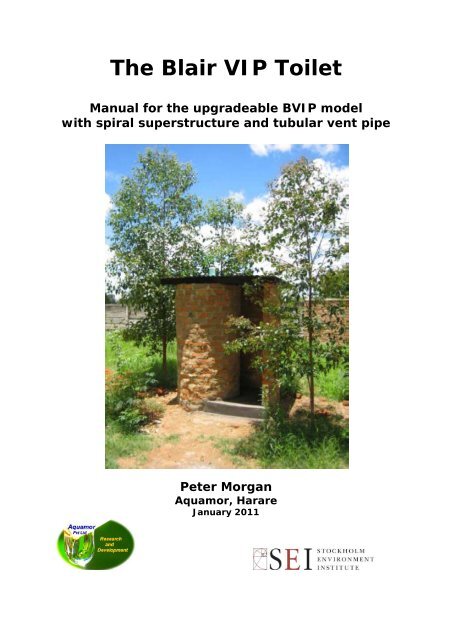
![Project Document [PDF: 2.31 MB] - EcoSanRes](https://img.yumpu.com/51279385/1/184x260/project-document-pdf-231-mb-ecosanres.jpg?quality=85)



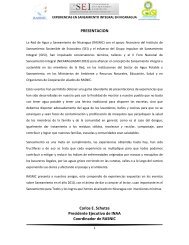
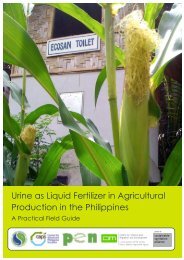

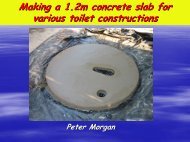



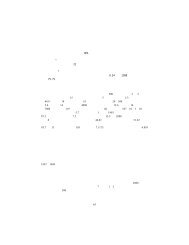


![Latrines à compost [high-resolution colour PDF: 12.3MB] - EcoSanRes](https://img.yumpu.com/31726141/1/185x260/latrines-a-compost-high-resolution-colour-pdf-123mb-ecosanres.jpg?quality=85)